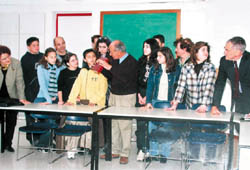Dr. Dickran Kouymjian

A remarkable Greek-American-Armenian adventure began in December 2002 when Armenian Studies was called to a meeting with Richard Jackson, President of the American College in Thessaloniki, Greece. It was Pres. Jackson’s second visit to our campus and as Barlow Der Mugrdechian and I found out, our President, John Welty, had visited Thessaloniki along with Dr. Berta Gonzalez head of our University exchange programs.
The remarkable aspect of that meeting was discovering that the American College, known as ACT for short, was once Anatolia College in Marsovan, Turkey, transferred after the Genocide (1923-4) to Greece by the Missionary Board. My mother had always told me and my brother Armen, that her father, Dikran Calusdian, after whom I was named, had been a teacher at Marsovan College. A packet of material, some in Armenian, on ACT offered to us by Richard Jackson had in it a photocopy of Anatolia College faculty with Xs marking those who had been killed during the Genocide. When I saw, I said, spotting one young professor with a closely cropped full beard, “That looks like my grandfather!”
During the meeting in Dr. Gonzalez’s office we discussed various exchange proposals between CSUF and ACT and Pres. Jackson also spoke of a Michael Dukakis Fellowship that brought visiting scholars to Thessaloniki. I expressed an interest if my schedule allowed such a visit. He promised to check on my grandfather’s name in the archives of the school. A month later I was given a Dukakis Fellowship to lecture in Thessaloniki.
The twelve day adventure was full of surprises and lots of work. The forty acre campus of the American College, on the heights overlooking Greece’s second city, with its magnificent port, is up in the hills just above the city. The space is now shared by two institutions with a single president: Anatolia College, a junior high and high school, the successor to the original one in Marsovan (Mersifon as the Greeks called it) and a four year liberal arts college, ACT, started 25 years ago by the then president Dr. William McGrew.
I gave my first guest lecture to combined Modern History classes on “Armenia and Armenians in Modern Historical Perspective.” I tried to compare modern Armenian history with modern Greek history and spent sometime explaining the genocide and its consequences.
Just after, at about 9 PM there was a formal reception for us at the President’s house with some of the administration and members of the Armenian community of Thessaloniki. We were told there were still some 2-3,000 Armenians in Thessaloniki and we did visit the church in the center of town; apparently twice that many new comers recently arrived from Armenia.
Monday morning, after a weekend touring the monasteries of the Meteora, began with a lecture to an American College art history class on early Armenian architecture and its comparison to the early Byzantine architecture of Thessaloniki, especially to the early churches of St. Demetrius and St. George. In the early evening I was invited to present a paper to the Liberal Arts Faculty Colloquium on the subject “When Does a Genocide End? The Armenian Case.” The two-hour affair also included a lively discussion session.
Wednesday was crowded with activities on and off campus in order for us to be free to tour around on our last two days. In the morning I led a class in Anatolia College of seventh and eighth graders on William Saroyan. Someone had heard that I had known the writer and coincidentally the English literature class was reading a story “The Miraculous Phonograph Record,” included in their English reader with the usual explanatory notes for students studying English as their second language.
In the early afternoon, one of the more unusual episodes unfolded around an old manuscript. Shortly upon our arrival, we were told by Richard Jackson and others about a rare medieval Armenian Bible, a treasure of the Anatolia College, kept in a safe on campus. I was asked if I would look at it and provide more information than the school had, of course I agreed with pleasure. I finally got to see the book and immediately reported that it was a Gospel book, not of the 11th-12th century as believed, but certainly of the 17th century or slightly later. I made a formal presentation of the manuscript to a group of Armenian students, adults and interested faculty, and used the occasion to give those present an illustrated lecture on how early Christian Gospels were copied, organized, and illustrated. After the slide show we all huddled in the conference room around the manuscript (with a modern red leather binding) and I started turning the pages one by one, explaining section by section, the work and its illustrations.
In the evening we were taken to the new Byzantine Museum for a lecture jointly sponsored by the Museum, ACT, and the local Armenian Hamaskaine Cultural Association. I gave a slide presentation on the miniatures of the Armenian version of the History Alexander the Great and the origins of its iconography. I centered much of the talk on the oldest illustrated Armenian version from the late 13th or early 14th century manuscript now with the Mekhitarist Fathers on the Island of San Lazzaro in Venice and compared them to the Greek tradition.
We came with expectation and left with joy in our hearts, excited that I too had taught in the same institution that I had always believed my maternal grandfather had been a teacher in before he was killed during the first weeks of the Genocide of 1915. The American College is a wonderful place. The graciousness of the administration and faculty, the beauty of the campus, its long academic tradition and its fine facilities, the open friendliness of the Greeks and the Mediterranean life style, make ACT a perfect institution for our CSUF students interested in studying abroad or for our Fresno State faculty to visit and lecture at.
 Hye Sharzhoom Armenian Action
Hye Sharzhoom Armenian Action